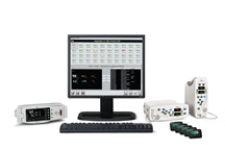
October 5, 2007 – Masimo said Oct. 4 it will launch its Patient SafetyNet, a new remote monitoring and clinician notification system, and showcase its Rainbow SET technology platform at the 2007 American Society of Anesthesiologists (ASA) Annual Meeting in San Francisco, Oct. 13-17.
Masimo Patient SafetyNet is an easy-to-use system that combines the company’s SET pulse oximetry with wireless clinician notification via pager. The company says this will provide a new level of patient safety on general care floors, where nurse-to-patient ratios preclude the level of direct surveillance required and recommended to pre-empt sentinel events. Numerous standards bodies, including the Joint Commission (JCAHO), the American Society of Anesthesiologists, the Anesthesia Patient Safety Foundation and the Institute for Healthcare Improvement, are calling for improved patient safety standards on general care floors.
The Patient SafetyNet is designed to keep at-risk patients safe on general care floors by connecting them to qualified caregivers quickly, easily, and accurately. When a Patient SafetyNet-monitored patient is in respiratory distress, meaningful and actionable alarms are generated by the Masimo bedside monitor and sent wirelessly to designated clinicians for review and response. As a result, appropriate clinical intervention can be initiated quickly, pre-empting sentinel events - defined by the Joint Commission as “an unexpected occurrence involving death or serious physical injury not related to the natural course of the patient's illness.”
The Masimo Patient SafetyNet system instantly routes bedside-generated alarms through a server to a qualified clinician’s hand-held paging device in real-time. For added safety, the system allows for automatic escalation of the alarm to additional clinicians when necessary. Each Masimo Patient SafetyNet system can support up to 40 bedside monitors and can either be integrated into a hospital’s existing IT infrastructure or operate as a stand-alone wireless network.
At the heart of Patient SafetyNet is Masimo SET pulse oximetry, which monitors SpO2 and pulse rate, even under the most difficult clinical conditions of patient motion and low peripheral perfusion. The company said previous attempts at developing general care floor monitoring systems were unsuccessful because the high volume of false pulse oximetry alarms generated by conventional pulse oximetry led systems to provide false alarms so often that clinicians ultimately ignored the alarms. Masimo says its SET device reduced false alarms by more than 90 percent and improved detection of true alarms to more than 97 percent.
The company will also be showcasing the Masimo Rainbow SET Platform at the ASA. The upgradeable multifunctional technology platform enables noninvasive, continuous blood constituent and functional hemodynamic monitoring. The Rainbow SET Platform allows clinicians to choose the features and measurements needed to meet their specific clinical requirements, and then upgrade to additional functionality whenever they choose. The devices come standard with Masimo SET pulse oximetry and clinicians can upgrade to additional measurements, including continuous noninvasive carbon monoxide (SpCO) and methemoglobin (SpMet) monitoring and Pleth Variability Index (PVI).
The company says by continuously, noninvasively and accurately determining levels of SpMet, clinicians can accurately determine if drugs they are administering are causing methemoglobinemia. The drugs that have been shown to contribute to methemoglobinemia include Benzocaine, Cetacaine and Prilocaine, Celecoxib, Dapsone, EMLA Creams, Flutamide, Nitrates, Nitric Oxide, Nitroglycerin, Sodium Nitroprusside, Sodium Nitrate and Sulfonamides.
In a surgical setting, continuous monitoring of SpCO can allow clinicians to detect elevated levels of carboxyhemoglobin that can be caused by everything from desiccated soda lime (“Monday Morning Phenomena”) or other poisons during surgery, to smokers reporting for surgery with high SpCO values. Increased SpCO compromises healing and may lead to death, and smokers with residual elevated COHb at the time of anesthesia are at cardiac ischemic risk.
Also for the first time at the ASA, Masimo will be showing its latest Rainbow measurement, Pleth Variability Index, or PVI. The ability to noninvasively measure and trend PVI, a continuous noninvasive quantified measurement of changes in the perfusion index that could be indicative of blood volume status, provides additional indicators of a patient’s physiologic condition, including the patient’s level of hydration.
